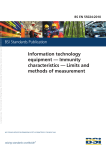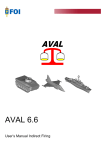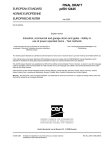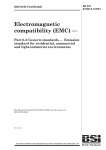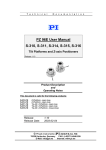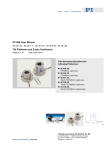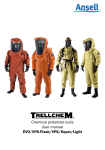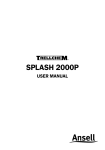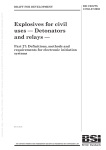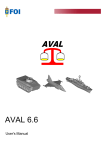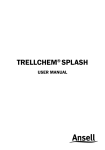Download DRAFT prEN 14225-2
Transcript
EUROPEAN STANDARD DRAFT prEN 14225-2 NORME EUROPÉENNE EUROPÄISCHE NORM July 2002 ICS English version Diving suits - Part 2: Dry suits, requirements and test methods This draft European Standard is submitted to CEN members for enquiry. It has been drawn up by the Technical Committee CEN/TC 162. If this draft becomes a European Standard, CEN members are bound to comply with the CEN/CENELEC Internal Regulations which stipulate the conditions for giving this European Standard the status of a national standard without any alteration. This draft European Standard was established by CEN in three official versions (English, French, German). A version in any other language made by translation under the responsibility of a CEN member into its own language and notified to the Management Centre has the same status as the official versions. CEN members are the national standards bodies of Austria, Belgium, Czech Republic, Denmark, Finland, France, Germany, Greece, Iceland, Ireland, Italy, Luxembourg, Malta, Netherlands, Norway, Portugal, Spain, Sweden, Switzerland and United Kingdom. Warning : This document is not a European Standard. It is distributed for review and comments. It is subject to change without notice and shall not be referred to as a European Standard. EUROPEAN COMMITTEE FOR STANDARDIZATION COMITÉ EUROPÉEN DE NORMALISATION EUROPÄISCHES KOMITEE FÜR NORMUNG Management Centre: rue de Stassart, 36 © 2002 CEN All rights of exploitation in any form and by any means reserved worldwide for CEN national Members. B-1050 Brussels Ref. No. prEN 14225-2:2002 E prEN 14225-2:2002 (E) Contents Foreword......................................................................................................................................................................3 Introduction .................................................................................................................................................................4 1 Scope ..............................................................................................................................................................4 2 Normative references ....................................................................................................................................4 3 Terms and definitions....................................................................................................................................6 4 4.1 4.2 4.3 4.4 4.5 4.6 4.7 Requirements .................................................................................................................................................8 General............................................................................................................................................................8 Mechanical requirements of the whole suit ................................................................................................8 Mechanical requirements of the material, seams and attachments .......................................................10 Construction requirements.........................................................................................................................11 Practical performance requirements .........................................................................................................13 Optional features..........................................................................................................................................13 Special protection ........................................................................................................................................13 5 5.1 5.2 5.3 5.4 5.5 Test methods................................................................................................................................................15 General..........................................................................................................................................................15 Mechanical test methods ............................................................................................................................16 Suit construction - tests..............................................................................................................................18 Practical performance test..........................................................................................................................20 Testing optional features ............................................................................................................................23 6 6.1 6.2 6.3 Marking .........................................................................................................................................................25 General..........................................................................................................................................................25 Specific marking ..........................................................................................................................................25 Special protection – additional marking....................................................................................................26 7 7.1 7.2 7.3 Information supplied by the manufacturer................................................................................................26 General..........................................................................................................................................................26 Consumer information at the point of sale ...............................................................................................26 Instructions for use .....................................................................................................................................27 Annex A (normative) Ratings of Thermal Comfort and Perceived Exertion .......................................................29 A.1 Thermal Comfort: Scale and Questionnaire..............................................................................................29 A.2 Perceived Exertion: Scale and Questionnaire ..........................................................................................29 Annex ZA (informative) Clauses of this European Standard addressing essential requirements or other provisions of EU Directives ........................................................................................................................30 2 prEN 14225-2:2002 (E) Foreword This document (prEN 14225-2) has been prepared by Technical Committee CEN/TC 162, "Protective clothing including hand and arm protection and lifejackets", the secretariat of which is held by DIN. This document is currently submitted to the CEN Enquiry. This document has been prepared under a mandate given to CEN by the European Commission and the European Free Trade Association, and supports essential requirements of EU Directive(s). This standard for dry diving suits is Part 2 of 4. The other parts are: Diving suits – Part 1: Wet suits; Diving suits – Part 3: Actively heated or cooled suits (systems); Diving suits – Part 4: One atmosphere suits. For relationship with EU Directive(s), see informative annex ZA, which is an integral part of this document. The annex A is normative. 3 prEN 14225-2:2002 (E) Introduction This European Standard has been prepared to meet the needs of persons engaged in underwater activities. It sets minimum performance requirements for manufacturers, purchasers and users in order to ensure that dry diving suits provide effective performance. Dry diving suits are defined as garments designed to cover all or part of the body, which are to be protected from the ingress of water when the diver is immersed. A dry suit may be comprised of one or more pieces, but all must meet the requirements of the standard. Dry suits may be used in conjunction with a range of accessories including passive and active undergarments, gloves, a hood and other head protection equipment. The compliance of a dry diving suit with this standard does not imply that it is suitable for all circumstances, nor does it make detailed provisions for all the special uses to which dry diving suits may be utilised. The primary aim in wearing a dry diving suit is to keep the diver dry by preventing the ingress of water and to enable the diver to maintain their buoyancy (and enable a diver to adjust the gas volume in the suit accordingly to their requirements). A dry suit manufactured for special purposes may also: a) provide or enable thermal insulation b) provide special protection in accordance with the claims of the manufacturer. The level of protection and performance offered by a dry suit may be altered by a number of factors, including the water temperature, the depth of the dive, the diver’s cold tolerance, his or her work rate and behaviour, and the manner in which the suit has been maintained. The degree of thermal protection offered by a dry suit is especially problematic. Appropriate material and manikin tests are being developed and refined, but at best they will only be able to provide broad indications of the likely protection provided by a particular suit to an individual diver. In order to make safe and appropriate use of a dry suit, users, owners and retailers must follow the manufacturer’s instructions. Dry suits are only to be used by those who have received recognised training or who are receiving training under the supervision of an appropriately qualified instructor. 1 Scope This European Standard specifies the minimum requirements for the construction, performance, safety, test methods, marking, labelling, user’s instructions, and information prior to purchase information of a dry suit for underwater activities where the user is breathing underwater. Laboratory and practical performance tests are included for the assessment of compliance with the requirements of this standard. 2 Normative references This European Standard incorporates by dated or undated reference, provisions from other publications. These normative references are cited at the appropriate places in the text and the publications are listed hereafter. For dated references, subsequent amendments to or revisions of any of these publications apply to this European Standard only when incorporated in it by amendment or revision. For undated references the latest edition of the publication referred to applies. 4 prEN 14225-2:2002 (E) EN 250:2000, Respiratory equipment — Open-circuit self-contained compressed air diving apparatus — Requirements, testing, marking. EN 340:1993, Protective clothing — General requirements. EN 369:1993, Protective clothing — Protection against liquid chemicals — Test method: Resistance of material to permeation by liquids. EN 1809:1997, Diving accessories — Buoyancy compensators — Functional and safety requirements, test methods. prEN ISO 12402-9, Personal flotation devices — Part 9: Test methods. EN 23758:1993, Textiles — Care labelling code using symbols. EN ISO 105-B04:1997, Textiles —Tests for colour fastness — Part B04: Colour fastness to artificial weathering: Xenon arc fading lamp test. EN ISO 105-E02:1996, Textiles Tests for colour fastness — Part E02: Colour fastness to sea water. EN ISO 105-X12: 1995, Textiles —Tests for colour fastness — Part X12: Colour fastness to rubbing. EN ISO 12894:2001, Ergonomics of the thermal environment — Medical supervision of individuals exposed to extreme hot or cold environments. EN ISO 13995:2000, Protective clothing — Mechanical properties — Test method for the determination of the resistance to puncture and dynamic tearing of materials. EN ISO 15027-1:2002, Immersion suits — Part 1: Constant wear suits, requirements including safety. EN ISO 15027-3:2002, Immersion suits —Part 3: Test methods. Interim DEF-STAN 53-100/1, UK MOD, Pressure sealed slide fasteners. International Convention for Safety of Life at Sea (SOLAS): 1974, Chapter III as amended by IMO resolution MSC 47(66) and LSA Code. Recommendation on retroreflective tapes on lifesaving appliances adopted by Resolution A.658(16), Annex 2. ISO 9227:1990, Corrosion tests in artificial atmospheres — Salt spray tests. ISO 10551:1995, Ergonomics of the thermal environment — Assessment of the influence of the thermal environment using subjective judgement scales. ISO/DIS 11610:1997, Glossary of terms and conditions. ISO 13934-2:1999, Textiles — Tensile properties of fabrics — Part 2: Determination of maximum force using the grab method. ISO/CD 9886:2000, Evaluation of thermal strain by physiological measurements. SS 019102, Colour Atlas − NCS Natural Colour System ASTM F1671-97-b:1997, Standard test method for resistance of materials used in protective clothing to penetration by blood-borne pathogens using Phi-X174 bacteriophage penetration as a test system. CIE 15.2:1968, Colorimetry. CIE 54:1982, Retroreflection: Definitions and measurement. 5 prEN 14225-2:2002 (E) 3 Terms and definitions For the purpose of this standard, the following definitions apply: 3.1 diving suit a suit designed for intended underwater activities, in which the user is breathing underwater 3.2 suit system a combination of diving suit components, undergarments and attachments that comprise a complete diving dry suit 3.3 dry suit a diving suit which covers all or only particular regions of the body and which is designed to prevent the ingress of water upon immersion 3.4 closure a device, f. ex. zipper, "touch and close" fastener, etc. to close openings for the donning of protective clothing 3.5 entry suit closure a water/gas tight closure used in donning or connecting the suit to a diving helmet or hood 3.6 diving suit attachment an item attached to the diving suit designed to exclude water 3.7 neck seal a closure used to make a water/gas tight seal around the neck 3.8 wrist seal a closure used to make a water/gas tight seal around the wrist 3.9 ankle seal a closure used to make a water/gas tight seal around the ankle 3.10 face seal a closure used to make a water/gas tight seal around the face 3.11 supplementary closure an additional closure used for access to the inside of the suit 3.12 medium pressure the pressure between the pressure reducer and a gas control system NOTE This is sometimes referred to as intermediate pressure. 3.13 low pressure the pressure within the dry suit, i.e. approximately ambient pressure 3.14 inflation device a device that allows gas to be added to the internal volume of the dry suit 6 prEN 14225-2:2002 (E) 3.15 deflation device a device, that allows gas to be released from the internal gas volume of the dry suit 3.16 manually operated deflation device a device activated by the diver 3.17 constant pressure deflation device a device, which works automatically at a predetermined pressure, and that cannot be adjusted 3.18 variable pressure deflation device an adjustable device that works automatically at a set pressure. The devices may incorporate a manually operated deflation function 3.19 inflation hose a hose used to supply pressurised gas to the inflation device 3.20 inflation hose quick disconnect the means of quickly detaching the inflation hose 3.21 single handed action the act of pulling, or simultaneously turning and pulling with one hand 3.22 undergarment a garment worn under the dry suit to provide insulation or thermal control 3.23 hypothermia the condition of human body in which the core temperature is below 35 °C 3.24 hyperthermia the condition of human body in which the core temperature is above 39 °C 3.25 diving environment the environment in which the wearer of a suit or suit system engage in diving activities 3.26 special case hazards diving environment diving environment suspected or known to contain hazardous pathogens, chemicals, radiation, sonic or electric fields, in which diving operations must be conducted 3.27 hazard the source of possible injury or damage to health 3.28 risk the combination of the probable occurrence of harm, and the severity of the harm 3.29 residual risk the risk remaining after protective measures have been taken 7 prEN 14225-2:2002 (E) 3.30 label an item permanently attached to a product that carries information related to parts or special features of the product 3.31 instruction for use information to enable suitably trained and qualified persons to select, wear and use the suit in a safe manner 3.32 consumer information at the point of sale information at the point of sale, to allow the consumer to select the correct dry suit and accessories for the activity they intend to undertake 3.33 thermal stress any change in the thermal relation between human and its environment which, if uncompensated by temperature regulation, would result in hyper- or hypothermia 3.34 umbilical hose and/or cable system for transferring gases, energy and/or communications to or from a diver 3.35 slide fastening closure with a fastening device consisting of two flexible interlocking strips and a slider 3.36 STPD Standard Temperature and Pressure Dry (273.15 K and 1.013 bar) 4 Requirements 4.1 General The dry suit or its material, fabrics, components and packaging shall not be damaged or fail in its determined function when tested according to the specification. If the diving suit incorporates additional items, none of them shall impair the suit's performance with respect to the requirements of this standard, either by their presence or their use. The diving suit shall allow the donning of other equipment, worn or attached to the diver. The suit shall have a fit that does not adversely affect the diver’s breathing. The internal pressure of the suit shall not increase the breathing effort required of the diver, unless a clear, explicit warning is provided in the user's manual. The diving suit shall be designed so as not to present a hazard to a diver and to minimise other risks to the diver. Any known health risk of the material shall be stated in ‘Information supplied by the manufacturer’ and checked when tested in accordance with 5.1.2 and 5.4. The overall requirements for a dry suit are summarised in Table 1, for suits with special protection in Table 2. 4.2 Mechanical requirements of the whole suit 4.2.1 Cold and Hot storage A suit, complete with all attachments including valves and hose shall withstand hot and cold storage when tested in accordance with 5.2.2.1. 8 prEN 14225-2:2002 (E) After each cycle the suit shall be subject to visual inspection (5.1.2). There shall be no signs of visible degradation, blocking, de-lamination or corrosion. 4.2.2 Sea water resistance The suits shall withstand exposure to seawater when tested in accordance with 5.2.2.2. The suits shall be subject to visual inspection (5.1.2) after each cycle. There shall be no signs of visible degradation, blocking, delamination or corrosion. 4.2.3 Cleaning and disinfection The suit shall not degrade when cleaned or disinfected in accordance with the manufacturers instructions for use when tested accordance with 5.2.2.3 and visually inspected (5.1.2). Table 1 — Dry Suits – Overall Requirements Requirements : Dry Suits Requirements Test Method X = requirement has to be met 0 = where present or claimed requirement has to be met Whole Suit Sizing 4.4.1 5.1.2 & 5.4 X Leakproof 4.4.4 5.3.2 & 5.4 X Hot and cold storage 4.2.1 5.2.2.1 X Sea water resistance 4.2.2 5.2.2.2 X Cleaning and disinfecting 4.2.3 5.2.2.3 & 5.5.2.3 X Practical performance 4.5 5.4 X Depth test 4.5 5.4 & 5.4.7.3 X Fit and visual inspection 4.5 5.1.2 & 5.4 X Puncture-tear resistance 4.3.1 EN ISO 13995 X Seam strength 4.3.2 ISO 13934 Part 2 X Attachments seam strength 4.3.3 5.2.2 & 5.2.3.1 O Tensile strength of slide fastening 4.3.4 5.3.2 & DEF STAN 53-100-1 O Tensile load 4.4.2.2 5.1.2 & 5.3.1.1 O Flexibility of supply hose 4.4.2.2 5.1.2 & 5.3.1.1 O Leakage 4.4.2 5.1.2 & 5.3.2 O Visual 4.4.2 5.1.2 & 5.3.1.1 O Suit bond test 4.4.2.3 5.3.1.2 O Reliability test 4.4.2.3 5.3.1.2 O Air flow 4.4.2.3 5.3.1.2 O Leakage test 4.4.2.3 5.3.2 O Suit Body Materials Inflation Devices Hose Inflation Valve 9 prEN 14225-2:2002 (E) Requirements : Dry Suits Requirements Test Method X = requirement has to be met 0 = where present or claimed requirement has to be met Connection strength 4.4.3 5.3.1.2, 5.3.3 & 5.4 Suit bond test 4.4.2.4 5.3.1.3 O Leakage 4.4.2.4 5.3.2 O Connection strength 4.4.3 5.3.3 O 6 5.1.2 & 5.4 X 7 5.1.2 & 5.4 X Deflation Devices Information Marking Information manufacturer supplied by Table 2 — Suits with Special Protection X = requirement has to be met Dry Suits with Special Claims Requirements Test Method Symbol O = where present or claimed requirement has to be met Thermal insulation 4.7.1 5.4 & 5.5.2.1 TH X Protection from chemical hazards 4.7.2 5.5.2.2 HZ X 5.1.2 & 5.4 NV X prEN ISO 12402-9 VIS X Suits for use without valves Suits to aid visibility 4.7.4 EN ISO 105-X12 EN ISO 105-E02 EN ISO 105-B04 4.3 Mechanical requirements of the material, seams and attachments 4.3.1 Puncture-tear resistance of suit material The materials shall achieve, with a 250 g blade, a performance of at least 1,7 Joule, at a mean tear length of more than 40 mm to all directions of tear relative to the roll (along, across, 45º) when tested in accordance with EN ISO 13995. 4.3.2 Suit seam strength The coupling (e.g. seam) of each combination of materials, but excluding wrist, ankle, neck or face seals used to manufacture the suit, shall withstand a tensile load of >100 N perpendicular to the seam when pre-treated in accordance with 5.2.2 and tested in accordance with ISO 13934 Part 2. 10 prEN 14225-2:2002 (E) 4.3.3 Attachments seam strength The strength of joints between the basic suit material found in areas such as the hood, gloves, neck or wrist seals, boots or socks, shall be no less than 100 N when pre-treated in accordance with 5.2.2 and tested in accordance with 5.2.3.1. 4.3.4 Dry slide fastening closures Any dry slide fastening closures shall be fit for purpose, shall not leak when tested in accordance with 5.3.2 and have a tensile strength of xx N (TBD) when tested in accordance with Interim DEF STAN 53-100/1. 4.4 Construction requirements 4.4.1 Sizing Manufacturers may specify any sizing system, in this event the sizing shall include at least height and chest girth. Sizing shall be and marked on the suit (6.2) clearly stated in the Information at the point of sale (7.2), Instructions for use (7.3). In the event that the manufacturer does not specify a specific sizing regime the system described in EN 340 shall be used. Testing shall be done in accordance with 5.1.2 and 5.4. 4.4.2 4.4.2.1 Internal volume control system General If devices for the suit's internal volume control are fitted, they shall be positioned in such a manner that they are easily manipulated when tested in accordance with 5.1.2, 5.3.1 and 5.4. 4.4.2.2 Inflation hose The tensile load (unpressurised), flexibility (unpressiurized), burst pressure and leakage of any medium pressure hose assembly shall be in accordance with EN 250. If the inflation hose is provided with a restrictor in order to limit the airflow, means to identify it as such shall be provided. This shall be stated in the information supplied by the manufacturer. Testing shall be done in accordance with 5.1.2 and 5.3.1.1. 4.4.2.3 Inflation device The inflation device shall be constructed in a way that it does not leak when the inflation hose is disconnected and tested in accordance with 5.3.1.2 and 5.3.2. A manually operated inflation device shall be capable of activation with a single gloved hand (three finger gloves, (5 -0/+2) mm thickness, double lined or permanently attached gloves) when tested in accordance with the 5.1.2 and 5.4. The connection of each suit inflation device shall not be damaged or leak when subjected to a pulling force of (500 -0/+10) N when tested in accordance with 5.1.2 and 5.3.1.2. -1 The inflation device shall provide an airflow rate of >100 l min STPD with a minimum supply pressure of 6 bar when tested in accordance with 5.3.1.2. The inflation device shall remain functional with supply pressures up to 20 bar. The inflation device shall not leak air during the periods that the device is either activated or inactive when tested in accordance with 5.3.1.2. 11 prEN 14225-2:2002 (E) The inflation device shall not leak when connected to a supply hose containing air at a pressure of (2 -0,2/+0) bar and also (30 -0/+3) bar when tested in accordance with 5.3.1.2. The inflation device shall be capable of being activated 1500 times, where each activation period is 5 s followed by a rest period of 5 s. The inflation device shall not leak air during the periods that the device is inactive when tested in accordance with 5.3.1.2. 4.4.2.4 Deflation device(s) The dry suit shall be provided with at least an automatic overpressure device and a manually operated deflation device. These two functions, automatic and manual, may be integrated into one unit. The device(s) must be easily operable with gloved hands three fingers, (5 -0/+2) mm thickness, and double lined or permanently attached gloves) when tested in accordance with 5.1.2 and 5.4. Provisions shall be taken to prevent unintentional, or inadvertent, activation of the deflation devices. The deflation device shall have a provision on the inside of the suit to ensure free gas flow to the device when tested in accordance with 5.1.2 and 5.4. The connection of the deflation device to the dry suit shall withstand a pulling force of (200 -0/+10) N for a test period of (10 -0/+5) s. The suit shall not leak and serviceability shall be retained when tested in accordance with 5.1.2 and 5.3.1.3. When tested in accordance with 5.3.1.3: The deflation devices shall not allow water ingress into the suit when tested in accordance with 5.3.1.3 and 5.4. The deflation devices shall enable the user to maintain a pressure of (18 -0/+2) mbar within the suit. At this -1 pressure, the total air leakage through the deflation devices must be <1 lh . The flow capacity of the manual deflation device shall exceed the flow capacity of the inflation device when fully open with a maximum pressure of 5 mbar inside the suit. The flow capacity of the overpressure device shall exceed the flow capacity of the inflation device, with a maximum pressure of 40 mbar inside the suit. If the overpressure valve is of the non-adjustable type, the pressure inside the suit during the actuation of the inflation device shall not exceed 40 mbar. If the overpressure valve is of the adjustable type, the pressure inside the suit during the actuation of the inflation device shall not exceed 25 mbar when the valve is at its minimum opening pressure setting and 40 mbar when at its maximum setting. 4.4.3 Connectors External suit connectors, e.g. the inflation hose, shall be capable of being readily connected and disconnected with gloved hands three fingers, (5 -0/+2) mm thickness, double lined or permanently attached gloves) when tested in accordance with 5.1.2 and 5.4. External suit connectors shall have a one handed, single action release mechanism. If a gas connection has a safety pull disconnection device, the gas supply shall not be disconnected with a tensile force lower than 125 N when tested in accordance with 5.1.2, 5.3.1.2, 5.3.3, and 5.4. 4.4.4 Leakage No part of the suit intended to be dry, other than a deflation device(s), shall leak or release gas when inflated with air at (25 ± 1) mbar and tested in accordance with 5.3.2 and 5.4. 12 prEN 14225-2:2002 (E) 4.5 Practical performance requirements The diving suit system shall provide sufficient mobility and flexibility to safely conduct the diving operation, including all emergency operations. The suit system shall be able to be donned and doffed with the assistance of no more than one person in all ambient temperatures including extreme cold. The requirements of this standard are intended to take account of the interaction between the wearer, any diving apparatus, the dry suit and where possible the environment in which the suit is likely to be used. See Annex ZA. In addition to the laboratory tests described (5.2, 5.3), the suit shall undergo practical performance tests (5.4) under realistic conditions. These practical performance tests serve the purpose to check the suit for imperfection and ergonomic aspects that cannot be determined by the tests described in other parts of this standard. Where in the opinion of the test panel, approval is not granted because practical performance tests show the suit has imperfections related to wearer’s acceptance, the test panel shall describe the tests that revealed these imperfections. This will enable other test stations to duplicate these tests and assess the results thereof. 4.6 Optional features When a manufacturer makes specific claims regarding the particular characteristics of a dry suit, these claims be in accordance with the appropriate EN, or EN ISO standards. The specific claims shall be clearly marked on the suit. If a hood is attached, it shall have the means to prevent the formation of a reduced or increased pressure in the outer ear relative to ambient pressure when tested in accordance with 5.1.2 and 5.4. 4.7 Special protection 4.7.1 Suits with thermal insulation The suit shall comply with any manufacturers claims for thermal insulation. If the manufacturer claims the suit material is of a thermal grade defined in Part 1 of this standard, it shall comply with the requirements of Part 1 of the standard. Cold dive shall be done in accordance with 5.4.7.4 and 5.5.2.1. 4.7.2 Chemical protection Where a suit is intended to provide the user with protection from the presence of chemicals in the environment, the suit shall not degrade when exposed to the chemical or allow the diver to be exposed to the chemical. Effective methods for decontaminating the suit shall be provided and no residual risks/contaminants are allowed. The manufacturer may specify one or several chemicals from the test battery (5.5.2.2) to demonstrate adequate protection. Testing shall be performed against suit material, critical interfaces and closures, i.e. seams, latex, and slide fastenings in accordance with EN 369 and results are expressed as an average normalized breakthrough time in minutes. Criteria for pass/fail definitions: < 20 minutes constitute a failure 20-60 minutes - protection index “L” > 60 minutes - protection index “H” 13 prEN 14225-2:2002 (E) Suits shall be marked with the appropriate symbols within the chemical pictogram and protection index “L” or “H” representing low or high respectively." 4.7.3 Biological protection Where a suit is intended to provide the user with protection from the presence of biological organisms and pathogens in the environment, the suit shall not degrade when exposed to the organisms or allow the diver to be exposed to the organisms when tested in accordance with ASTM F1671-97b including modifications given in 5.5.2.3. The suit shall be able to be decontaminated in accordance with the manufacturers instructions, no residual risks are allowed. 4.7.4 4.7.4.1 Visibility Colour Any portion of the suit intended to be used to aid surface and underwater visibility shall be in the colour range from yellow to red within the colour volumes correspond to the colour volume of 0070-, 1070- in tones, 0080-, 0080- Y 30R-Y 80R, 1080-, 0090- and 0070-, 0080- in tones, 0090- Y-Y 20R in NCS colour space. The colour shall be measured after Xenon test in accordance with ISO 105-B04. Illumination shall take place to class 5 to 6 with ½ tolerance and cromaticity shall lie within the areas defined in Table 3 and Table 4. The colour shall be measured in accordance with the procedures defined in CIE publication No.15.2 with polychromatic illumination D65 and 45/0 geometry and 2° standard observer. The specimen shall have a black underlay with reflectance of less than 0,04. The specimens shall be conditioned for at least 24 h at (20 ± 2) °C and 65 ± 5) % relative humidity. If the test are carried out in other conditions, the test shall be conducted within 5 min after withdrawal from the conditioning atmosphere. The colour of suits shall be resistant to rubbing (wet and dry), when tested in accordance with EN ISO 105-X12 to at least class 3, and to salt water when tested in accordance with EN ISO 105-E02 to at least class 4. Table 3 — Cromaticity coordinates x and y and luminance b for proposed colours of suits in XYZ colour space corresponding NCS colour space Chromaticity Coordinates 14 Luminance x y β 0,389 0,426 0,920 0,377 0,409 0,836 0,425 0,475 0,809 0,427 0.478 0,867 0,528 0,371 0,475 0,521 0,369 0,433 0,414 0,342 0,573 0,438 0,438 0,592 prEN 14225-2:2002 (E) Table 4 — Cromaticity coordinates x and y and luminance ßmin for proposed yellow, orange-red and red fluorescent colours Cromaticity Colour Fluorescent yellow Fluorescent orange-red Fluorescent red NOTE Coordinates x y 0,387 0,610 0,356 0,494 0,398 0,452 0,460 0,540 0,610 0,390 0,544 0,376 0,579 0,341 0,655 0,344 0,655 0,344 0,579 0,341 0,606 0,314 0,690 0,310 Minimum luminance factor βmin 0,76 0,40 0,25 For search and rescue, yellow-orange and red orange, preferably fluorescent paints are superior in detectability. The visibility of the suit shall be tested in accordance with 5.1.2 and 5.4. 4.7.4.2 Retroreflective material -2 There shall be affixed to the suit surface at least XXX cm (TBD) area of material which is retroreflective of light and conforms to the specification detailed in IMO SOLAS 83 Chapter III, Resolution A.658(16), Annex 2. These area ares shall be located .......... (TBD). The performance of the retroreflective material shall not degraded by its application. Testing e.g. in accordance with modification of the test method CIE No.54: 1982 (TBD) or 3.11.6.4.2 of EN ISO 15027-3: 2001. 5 Test methods 5.1 General At least three dry suits, including each size if applicable, shall be submitted for visual inspection (5.1.2) and testing. One suit shall undergo laboratory tests (5.2, 5.3), and all three suits shall undergo practical performance tests under realistic conditions (5.4). If the suits fail the practical performance tests due to the lack of wearer acceptance, the test panel shall describe the reason(s) for failure. This will enable other test houses to duplicate these tests and assess the results thereof. NOTE If no special measuring devices or methods are specified, commonly used methods and devices shall be applied. 15 prEN 14225-2:2002 (E) 5.1.1 Test sequence The required tests shall be conducted in accordance with the flow chart (Figure 1). 5.1.2 Visual Inspection Visual inspection shall be carried out at normal acuity by the test station prior to and after laboratory or practical performance tests. This may entail a certain amount of dismantling in accordance with the information supplied by the manufacturer for maintenance. The visual inspection shall verify that the suit has been produced in accordance with the manufacturer’s technical file and include marking and information supplied by the manufacturer. 5.2 Mechanical test methods 5.2.1 General All material samples and the whole suit submitted for mechanical tests shall be pre-treated according to 5.2.2. 5.2.2 5.2.2.1 Pre - treatment Cold and Hot storage test, and inflation resistance test Store a complete suit as recommended by the manufacturer with all attachments including valves and attached hose for 4hrs at (+70 ± 2) °C. Then store the suit for 4hrs (-20 ± 2) °C. Apply four cycles with a maximum of 16 hours between each cycle. Visually inspect (5.1.2) the suit after each cycle. Within 5 minutes of completing the final cycle hang the suit at standard room temperature of (18 -0/+4) °C. 15 minutes after the end of the final cycle inflate the suit up to (25 -0/+2) mbar and leave for a period of 15 minutes. Visually inspect the suit (5.1.2). 16 prEN 14225-2:2002 (E) 1 suit Leakage test 1 (5.3.2) Cold and hot storage (5.2.2.1) Sea water resistance (5.2.2.2) Cleaning and disinfection (5.2.2.3) Volume control system tests (5.3) Practical performance (5.4) Thermal performance (5.5.2.1) Leakage test 2 (5.3.2) Suit seam, attachment seam, and slide fastening strength (4.3.2, 4.3.4, 5.2.3.1) Puncture - tear resistance (4.3.1) Additional tests (5) Figure 1 — Test flow chart 5.2.2.2 Sea water resistance test Sea water exposure in accordance with the ISO 9227. Submerge the un-inflated suit in artificial sea water (Annex A of EN 1809) of between 15 °C and 25 °C for 8h + 5 min. Without cleaning the suit in fresh water, the dry suit shall air dry for 16 h + 30 min at a temperature between 15 °C and 25 °C, and at a relative humidity of not more than (75 ± 5) %. Apply four cycles. Visually inspect (5.1.2) the suit after each cycle. 17 prEN 14225-2:2002 (E) 5.2.2.3 Cleaning, disinfecting and if required decontamination Use the procedures recommended by the manufacturer. The concentrations and immersion times indicated in the instructions for use are to be doubled. Perform the test 10 times. In so far as no other temperatures are indicated the temperature of the cleaning or disinfectant solution shall be (25 ± 2) °C. Visually inspect the suit (5.1.2). 5.2.3 5.2.3.1 Mechanical tests Pull test of attachments Attach the suit material part of an attachment joint to a fixed clamp. Apply a second clamp to the attachment and apply a 100 N force in the foreseeable direction of stress for a period of 5 minutes. The joint shall not show any sign of permanent deformation or tearing. 5.3 Suit construction - tests 5.3.1 5.3.1.1 Internal volume control system Inflation hose The tensile load and flexibility of the unpressurised hose shall be tested in accordance with EN 250. Similarly the leakage of and burst pressure of any medium pressure hose assemblies shall be tested in accordance with EN 250. The inflation hose shall be visually inspected. Measurement of airflow shall be performed to ensure that flow restriction does not exceed the manufacturer's stated value. 5.3.1.2 Inflation device The bond between the suit inflation device and the dry suit shall withstand a pulling force of (500 -0/+10) N for a test period of (10 -0/+5) s. The suit shall not leak and serviceability shall be retained. The inflation device with the supplied hose shall be connected to an air supply pressure of 6 bar. The outlet of the inflation device shall be connected to a flow meter. On activating the inflation device, the recorded outlet flow rate -1 shall be >100 l min STPD. The inflation device with the supplied hose shall be connected to an air supply pressures of 20 bar. The inflation device shall be activated 50 times, where each activation period is 5 s followed by a rest period of 5 s. The inflation device and hose shall be submerged in water for the duration of the test. The inflation device shall remain functional and not leak. The inflation device with the supplied hose shall be connected to a supply pressure of (2 -0,2/+0) bar and of (300/+3) bar for 60 s. The inflation device and hose shall be submerged in water for the duration of the test. The inflation device shall remain functional and not leak. The inflation device with the supplied hose shall be connected to an air supply at the manufacturers recommended pressure. The inflation device shall be activated 1500 times, in which each activation period is 5 s followed by a rest period of 5 s. The inflation device and the supplied hose shall be submerged in water for the duration of the test. The inflation device shall remain functional and not leak. During the leakage test (5.3.2) the hose shall be disconnected. Check for any leakage from the inflation device. 5.3.1.3 Deflation device(s) The connection of each suit deflation device shall not be damaged or leak when subjected to a pulling force of (200 -0/+10) N. Air leakage and flow tests shall be conducted on each deflation device using the apparatus in Figure 2. 18 prEN 14225-2:2002 (E) Attach the deflation device to be tested to apparatus and seal the apparatus; remove and blank the inflation device port. Introduce approximately 300 ml of water into the manometer. Open the tap on the pressurised air supply and pressurise the apparatus to (20 +/-2) mbar. Close the tap to the air supply and commence the test. As required, water shall be introduced into the manometer from a measured reservoir in order to maintain the manometer at (18 -0/+4) mbar. After 1 hour the amount of water introduced into the manometer from the measured reservoir shall be recorded. The amount of water introduced into the manometer shall not exceed 1000 ml. With a flow through the apparatus in Figure 2 set by the inflation device, the deflation device shall maintain the requisite pressure within the apparatus. Figure 2 – Volume control valves air leakage and flow test apparatus 5.3.2 Leakage test A complete suit, with or without valves as per its intended use, shall be used for the test. If attachments, such as a hood, helmet, gloves or boots, are intended to be dry, their performance shall be tested. All seals of the suit shall be shut. The suit may also be tested inside out, based on the manufacture's specification. The suit shall be inflated with air up to a minimum pressure of 25 mbar and totally submerged in water. Surface air on the suit may be wiped clear at the start of the test and the suit then left immersed for a minimum period of 15 minutes. The test shall be conducted with the suit held horizontal both prone and supine. The suit shall not allow the escape of more than one bubble of gas, during the final minute of the 15-min exposure. 19 prEN 14225-2:2002 (E) 5.3.3 Inflation and deflation device connections The connection of each suit inflation and deflation device to the dry suit shall be subjected to a pulling force of (500 -0/+10) N and (200 -0/+10) N respectively for a test period of (10 -0/+5) s. The force shall be applied to the hose in two directions, parallel and perpendicular to the suit surface. Check for visible damage and during the leakage test (5.3.2) check for any leakage from or around the inflation device. It shall be possible to disconnect the external connector. Disconnect the hose during the second leakage test of the test cycle (Figure 1). A load of 125 N shall be applied to a safety pull disconnection device. 5.4 Practical performance test 5.4.1 General For reasons of safety the practical performance test shall only be carried out at the point indicated in the test flow chart (Figure 1). All dive operations shall be conducted in accordance with national dive regulation and in accordance with the Declaration of Helsinki (World Medical Association, 1964 as amended at Edinburgh 2000 ) and national rules and regulations such as approval of test methods by a national ethic committee. Special requirements for conducting cold test dive for suits with thermal insulation (5.4.7.4). 5.4.2 Sampling At least 3 suits shall be of different size ranges as stated by the manufacturer. 5.4.3 Test panel The test shall be conducted in front of test panel of not less than three people, experienced in the use and assessment of this type of suit. 5.4.4 Test subjects The suit shall be tested by at least three test subjects who are at least 18 years old and practising regularly with dry suits. Their medical history shall be known to be satisfactory. They shall be medically examined and certified fit to undertake the test procedure. They shall be informed and instructed on the objectives of the tests. All essential body functions shall be monitored and reported during the test. One of the test divers shall be female. Test subjects for suits designed for women shall be female. Each subject shall wear a suit of a size category suitable for their build. At least one of the subjects (subject to age constraints) shall have a body size within the lowest of the manufacturer's stated size range, preferably at the lower end of the range. One shall be in the highest size range, preferably at the highest end of the range (See an example in Table 4). 20 prEN 14225-2:2002 (E) Example: Table 5 — Subject requirements for a manufacturer's stated suit size range Manufacturer's stated suit size range Size 5.4.5 Subject requirements Height, cm Chest girth, cm Height, cm Chest girth, cm Small (S) 170-182 88-96 170-174 88-92 Medium (M) 182-194 96-104 190-194 100-104 Large (L) 194-200 104-112 194-200 104-112 Test clothing Where test clothing to be used with the dry suit has not been specified by the manufacturer, then the following underclothing and additional clothing items appropriate to the dive shall be used: Underwear with long sleeves and long legs Insulating fleece or wool intermediate garment If necessary a test subject may also wear: Socks Gloves Three finger foam neoprene gloves, (5 -0/+2) mm thickness, double lined, if others are not permanently attached. Foam neoprene socks ( 5 -0/+2) mm, double lined, if others are not permanently attached Insulated foam neoprene hood (5 -0/+2) mm, double lined, if others are not permanently attached. 5.4.6 Diving Equipment The diver shall use diving equipment specified by the suit manufacturer. If none is specified the following shall be used: Breathing apparatus in accordance with EN 250 and with cylinder of at least 10 l water capacity and a working pressure of 200 bar Buoyancy compensator (BC) in accordance with EN 1809 Face mask (including communication when required) Fins Weights (according to the User’s Manual) Knife Lifeline to surface. 21 prEN 14225-2:2002 (E) 5.4.7 Test procedure Each diver shall read the information at the point of sale, the instructions for use and the marking for the suit. Each diver shall perform two or three dives, if a special protection cold dive is required, and undertake the following tests. 5.4.7.1 Cold donning Cold donning according to prEN 15027-3: 2000, test to be performed at (-20 ± 1) °C. 5.4.7.2 Test dive Test Procedure: 1) Donning a suit (assistance is allowed) according to the instructions provided by the manufacturer. Test panel shall verify the information given by the manufacturer concerning correct sizing. 2) Donning a hood if not permanently attached 3) Assess neck seal (individually trimmed, if required, to a correct fit) 4) Assess face seal (individually trimmed, if required, to a correct fit) 5) Walk at least 250 m (on wet surface and uneven ground) 6) Donning the breathing apparatus (assistance is allowed) 7) Donning the fins. 8) Donning the 3-finger wet gloves if not permanently attached 9) Jumping feet first into the water from the height of 2 m 10) Balancing on the surface with an un-inflated BC 11) Swimming on the surface with an un-inflated BC: 25 m face-down, 25 m face-up 12) Controlled descending with an un-inflated BC in an upright position (feet first), minimum depth 3 m 13) Check the reach and operation of all equipment (valves, weights, and knife). 14) Check buoyancy control in different positions with an un-inflated BC. Ascend to 2 m and demonstrate buoyancy control. Demonstrate ability to turn 360° vertically and horizontally from a stable, face-down position back to the starting position. 15) Controlled ascending in a upright position with an un-inflated BC 16) Dive/in water time shall be of at least 30 minutes duration 17) Doffing the fins in the water 18) Climbing at least 5 m on vertical ladders 19) Doffing the equipment (assistance is allowed) 20) Doffing the hood 21) Doffing the suit according to the instructions provided by the manufacturer (assistance is allowed). 22 prEN 14225-2:2002 (E) 5.4.7.3 Depth dive Test Procedure: 1) Each test diver shall make a dive to a depth of at least 15 metres for a total dive/in water time of 15 minute. 2) The dive shall be conducted with a lifeline. 3) The descent shall be controlled and with an un-inflated BC. 4) Check the function, ergonomics and operation of all equipment. 5) Where appropriate check hood venting. 6) Complete dive with a controlled ascent in an upright position with an un-inflated BC. 5.4.7.4 Cold dive (only for suits with thermal insulation) 5.4.7.4.1 General The dive is to be performed with suits with claims of inherent thermal properties, or suit systems that include thermal protective underwear according to the manufacturer’s instructions. For diving in cold water, appropriate underwear must be worn. 5.4.7.4.2 Testing laboratory requirements The testing laboratory has to take care of the subjects´ safety by medical check-up and monitoring cardiac functions (ECG, HR), rectal and skin temperatures in accordance with ISO 9886. The preparation, the test and the follow-up have to be supervised by a physician experienced with the medical treatment of hypothermia. The standards and EN ISO 12894:2001 should be considered. 5.4.7.4.3 Test Procedure Each subject shall make a dive of 60 min in duration in a water temperature of (4 ± 1) °C, or the minimum temperature specified by the manufacturer. The subject shall wear the requisite test clothing and equipment and dive to a maximum depth of 3 metres. During the diving period the diver is allowed to perform body movements but the activity shall not include moderate or heavy exercise. Ratings of physical exertion, general and local thermal comfort (Annex A) are requested at the beginning, at 10 minute intervals, and at the end of the dive. 5.4.8 Pass / fail criteria Due to the variability between subjects and the difficulty in assessing some subjective measures, it is permitted that a suit does not completely meet the requirements of the subjective practical performance tests in a single sample and in one test subject. In these circumstances, two other subjects within the same weight category and with the same sex, should be subjected to the same test and before the same test panel. If this additional test is still not clearly passed then the suit shall be deemed to have failed, whilst if it as clearly passed, the test panel may deem that the suit has passed the test overall. 5.5 Testing optional features 5.5.1 General If the manufacturer claims that a dry suit has a specific optional feature(s), this feature shall be tested according to the appropriate EN, or EN ISO standard. 23 prEN 14225-2:2002 (E) 5.5.2 Special protection 5.5.2.1 Suits with thermal insulation The ability of these suits to offer thermal protection shall be explained in the instructions for use, and a clear warning provided as to the hazards of low body core or/and skin temperatures. If thermal protection decreases with depth this shall also be included in the instruction for use. During the practical performance test (5.4), the cold water test dive (5.4.7.4) shall be conducted for at least 60 minutes using a complete suit assembly and in the minimum water temperature recommended by the manufacturer. At no stage during the dive shall the wearer report Thermal Comfort vote 4 or below on the scale A.1 shown in Annex A, and respectively, report Perceived Exertion vote 7 or below on the scale A.2 shown in Annex A. 5.5.2.2 Protection from general or specific chemical hazards Testing shall be performed on suit materials and critical interfaces, i.e. seams, latex, and slide fastenings. Diving suits claiming chemical and biological resistance shall be tested for materials specified by the manufacturer. The chemical categories listed in Table 5 are for guidance of manufactures. The chemicals chosen for guidance do not include the hazardous chemicals one would expect to encounter most frequently, but rather the most aggressive chemicals within a given chemical class. This choice is based on the assumption that a less aggressive chemical (i.e. larger molecular structure) will have a slower and/or longer time to permeate the material. Table 6 — Test chemical categories for chemical protection Category Symbol Chemical Cas-nr. Chemical family Acids Ac HZSO4 50 % 7664-93-9 Inorganic acid Bases Bs Na OH 50 % 1310-73-2 Alkaline solution Polar solvent Ps Isopropanol 67-63-0 Alcohol Hydrocarbon Hc Toluene 0.05 % 108-88-3 Aromatic Liquid B –70 % iso-octane/ 50 % toluene Fuel oils 5.5.2.3 F Liquid F – 80 % paraffin oil/20 % methyl napthalene Petroleum Diesel/ fuel aviation Decontamination from specific biological hazards Biological decontamination shall be tested in accordance with ASTM F1671-97b including the following modifications: Contamination: Four swatches (replicates) of material are to be used Bacteriophage Phi-X 174 of known titer will be added to the outside surface of the material Allow solution to remain in continuous contact with the outside surface of the material for 60 min Pour off excess phage solution Check titer of post challenge phage to ensure viability during challenge. Rinse: 24 prEN 14225-2:2002 (E) Rinse the outside surface of each swatch with distilled water followed by a mild scrubbing motion using a common household toothbrush. Final rinse. Collection: Outside surface of each replicate will be washed using 2 ml of sterile nutrient broth. Assay: 0,5 ml of collection solution from each replicate will be assayed for the presence of plaques (PFU’s) The presence of 1 PFU or more indicates a “failure” of the test. Suits shall be marked appropriately. 6 Marking 6.1 General Each piece of the diving suit shall be marked. The marking shall be: on the product itself or on labels permanently attached to the suit visible before the garment has been donned durable for the appropriate number of cleaning processes large enough to be immediately readable allow the use of readily legible characters, numbers shall be no smaller than 2mm and pictograms no smaller than 10 mm. NOTE It is recommended that the characters shall be black on a white background. Any label bearing this marking shall be permanently affixed to the suit, be resistant to salt water and withstand the cleaning test (5.2.2.3) in accordance with the manufacturers instructions. Neither shall the label shrink so as to affect the performance of the suit or its own performance or legibility. 6.2 Specific marking The marking shall include the following information: The manufacturer shall be identified by name, trademark or other means of identification Type identifying marking and unique serial or batch number Specific marking accordingly to the type of suit (e.g. dry) The number of this European Standard Size designation in accordance with EN 340 Level of performances (pictograms) Care labelling (pictograms accordingly to EN 23758) 25 prEN 14225-2:2002 (E) The maximum number of cleaning operations (if applicable) Cases in which the reliable performance of components may be affected by ageing or use. The date (at least the year) of manufacturing shall be marked Sub-assemblies and components with a considerable bearing on safety shall be marked so that they may be easily identified. If such sub-assemblies are too small to be marked or where it is impractical to mark them, the information shall be included in the instructions for use All suits shall carry a warning, which shall state "that the suit is only to be used by those who have been trained or under supervision by an industry recognised diving instructor" Warning directing the user to read the instructions for use Warning about possible risks e.g. potential buoyancy changes with depth and allergy, induced by materials used in the product. 6.3 Special protection – additional marking Where appropriate, suits shall be marked with a warning, containing the requisite symbol (pictogram), if available, and text. 7 Information supplied by the manufacturer 7.1 General On delivery, each suit shall include information to enable trained and qualified persons to select, wear, and use the suit in a safe manner. The information supplied by the manufacturer shall be unambiguous and in the official language(s) of the country of application. The following information shall be given: Name and full address of the manufacturer and/or his authorized representative. Type – Identification Number of this European Standard Contents list List of accessories and spare parts Explanation of any pictogram and markings The name, the address, and the identification number of the notified body which has type examined the product. 7.2 Consumer information at the point of sale Consumer information shall allow the consumer to make a rational choice and so minimize the risk of incorrect purchase and use. The information shall cover all the essential characteristics of the diving suit. It must accompany the suit and be easily visible and available to the consumer at the point of sale before the purchase. The information shall contain at least the following: 26 prEN 14225-2:2002 (E) Conditions and limitations of use Gender (If applicable) Size designation in accordance with EN 340 Compatibility with other diving equipment Level of performance General warning about possible risks, e.g. allergy, induced by materials used in the product Specific information according to the type of suit (e.g. dry). 7.3 Instructions for use The instructions for use shall give enough information on at least on the following: Application: Maximum depth of certification Limitations on use. Inflation gases (use air) Specific items according to the suit type Assembly - size designation: Components Connectors Safety devices Specific items accordingly to the suit type Assessment of risk: Temperature conditions Thermal protection, hyperthermia and hypothermia Work rates Change of buoyancy with depth Loss of thermal insulation at depth Fitting of the suit Inflation gases (increased risks with argon and oxygen enriched gas) Residual risks Specific items according to the suit type Explanation and warning about possible risks, e.g. allergy, induced by materials used in the product 27 prEN 14225-2:2002 (E) Suit checks: Prior to use Post dive Sizing, donning, fitting, and doffing. Use during dive Ascending: When appropriate or according to the manufacturer's recommendation, e.g. tender line, BCD Maintenance, repair and modification Inspection intervals Cleaning, disinfecting and if appropriate decontamination Storage: Shelf life (where applicable) Precautions The type of package suitable for transport if relevant. Safe disposal. 28 prEN 14225-2:2002 (E) Annex A (normative) Ratings of Thermal Comfort and Perceived Exertion A.1 Thermal Comfort: Scale and Questionnaire Scale 1 2 3 4 5 6 7 8 9 10 11 12 13 Questionnaire So cold I am helpless Numb with cold Very cold Cold Uncomfortably cold Cool but fairly comfortable Comfortable Warm but fairly comfortable Uncomfortably warm Hot Very hot Almost as hot as I can stand So hot I am sick and nauseated A.2 Scale G - Respiratory Tract.. ❏ H - Head..................... ❏ J - Trunk..................... ❏ K - Feet...................... ❏ L - Legs...................... ❏ M - Hands................... ❏ O - Overall..................❏ Perceived Exertion: Scale and Questionnaire Questionnaire 0 Nothing at all A - Overall Work Effort.. 0,5 Very, very weak (just noticeable) B - Legs Effort............... 1 Very weak C - Breathing Effort....... 2 Weak (light) 3 Somewhat strong 4 5 Strong (heavy) 6 7 Very strong 8 9 10 Very, very strong (almost maximum) * Maximal ❏ ❏ ❏ 29 prEN 14225-2:2002 (E) Annex ZA (informative) Clauses of this European Standard addressing essential requirements or other provisions of EU Directives This European Standard has been prepared under a mandate given to CEN by the European Commission and the European Free Trade Association and supports essential requirements of EU Directive 89/686/EEC. WARNING: Other requirements and other EU Directives may be applicable to the product(s) falling within the scope of this standard. Compliance with the clauses of this standard provides one means of conforming with the specific essential requirements of the Directive concerned and associated EFTA regulations. The following clauses of this standard are likely to support requirements of Directive 89/686/EEC, Annex II: Clauses of this standard EU-Directive 89/686/EEC, Annex II 4.5 1.1.1 Ergonomics 4.1, 4.5 1.1.2.1 Highest level of protection possible 4.6, 4.7 1.1.2.2 Classes of protection appropriate to different levels of risk 4.1, 4.4.2, 4.4.3, 4.4.4, 1.2.1 Absence of risks and other inherent nuisance factors 4.5 4.1 1.2.1.1 Suitable constituent materials 4.5 1.2.1.2 Satisfactory surface condition of all PPE parts in contact with the user 4.4.1, 4.5 1.2.1.3 Maximum user impediment 4.4.1, 4.5 1.3.1 Adaptation to users morphology 4.2, 4.3 1.3.2 Lightness and design strength 4.1, 4.5 1.3.3 Compatibility of different classes or types of PPE designed for simultaneous use 7 1.4 Information supplied by the manufacturer 4.2.3, 7.3 2.4 PPE subject to aging 6 2.12 PPE bearing one or more identification or recognition marks directly or indirectly relating to health and safety 4.7.4 2.13 PPE in the form of clothing capable of signalling the user's presence visually 4.7.1, Annex A 3.7 Protection against cold 4.7.2, 4.7.3 3.10.2 Protection against cutaneous and ocular contact 4.7.1 3.11 Safety devices for diving equipment 30






























